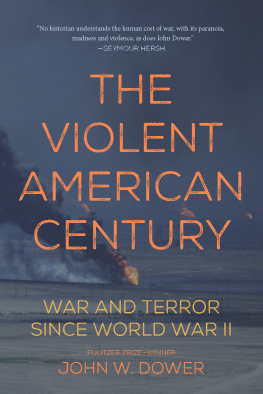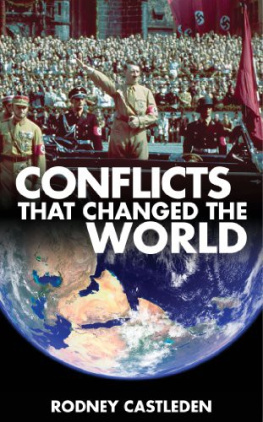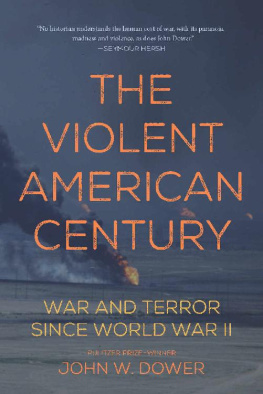John Dower ends this grim recounting of seventy-five years of constant war, intervention, assassination, and other crimes by calling for serious consideration of why the most powerful nation in world history is so dedicated to these practices while ignoring the nature of its actions and their consequencesan injunction that could hardly be more timely or necessary as the Pentagons arc of instability expands to an ocean of instability and even an atomic arc of instability in Dowers perceptive reflections on todays frightening world.
Noam Chomsky
No historian understands the human cost of war, with its paranoia, madness, and violence, as does John Dower, and in this deeply researched volume he tells how America, since the end of World War II, has turned away from its ideals and goodness to become a match setting the world on fire. George W. Bushs post-9/11 global war on terror was not a new adventure, but just more of the same.
Seymour Hersh
In The Violent American Century , John Dower has produced a sharply eloquent account of the use of US military power since World War II. From hot Cold War conflicts to drone strikes, Dower examines the machinery of American violence and its staggering toll. This is an indispensable book.
Marilyn Young
John Dower is our most judicious guide to the dark underbelly of postwar American power in the world. Those who focus on Europe and North America speak of a Pax Americana. This is to ignore the technologies of violence that Washington meticulously deployed in Asia and the global South, from total war to shock and awe, of which Dower is our unflinching analyst.
Juan Cole
A lucid, convincing, and chilling account of the self-deceiving American fall into violence. Dowers clear-eyed analysis of a terrible history, for its faith in the power of truth, invites a fresh determination to demand another way. Just in time.
James Carroll
A timely, compact, and utterly compelling expos of the myriad contradictions besetting US national security policy. John Dower has written a powerful book.
Andrew J. Bacevich
If you think that because weve never experienced World War III the world is becoming far more peaceful, John Dowers book is mandatory reading. In clear, carefully documented fashion, this superb historian shows just how much violence the United States has unleashed outside its borders since 1945, so much of it below the radar of our awareness at the timeand of our memories today.
Adam Hochschild
Chapter 1
MEASURING VIOLENCE
We live in times of bewildering violence. In 2013, the chairman of the Joint Chiefs of Staff told a Senate committee that the world is more dangerous than it has ever been. Statisticians, however, tell a different story: that war and lethal conflict have declined steadily, significantly, even precipitously since World War II.
Much mainstream scholarship now endorses the declinists. In his influential 2011 book, The Better Angels of Our Nature: Why Violence Has Declined , Harvard psychologist Steven Pinker adopted the labels the Long Peace for the four-plus decades of the Cold War (194591), and the New Peace for the postCold War years to the present. In that book, as well as in post-publication articles, postings, and interviews, he has taken the doomsayers to task. The statistics suggest, he declares, that today we may be living in the most peaceable era in our speciess existence.
Clearly, common sense must seek out a middle ground, acknowledging that the number and deadliness of global conflicts have indeed declined since World War II, without engaging in extravagant phrasemaking about peace. This so-called postwar peace was, and still is, saturated in blood and wracked with suffering.
It is reasonable to argue that total war-related fatalities during those Cold War decades were lower than in the six years of World War II (193945) and certainly far less than the toll for the twentieth centurys two world wars combined. It is also undeniable that overall death tolls have declined further since then. The five most devastating intrastate or interstate conflicts of the postwar decadesin China, Korea, Vietnam, Afghanistan, and between Iran and Iraqtook place during the Cold War. So did a majority of the most deadly politicides, or political mass killings, and genocidesin the Soviet Union, China (again), Yugoslavia, North Korea, North Vietnam, Sudan, Nigeria, Indonesia, Pakistan/Bangladesh, Ethiopia, Angola, Mozambique, and Cambodia, among other countries. The end of the Cold War certainly did not signal the end of such atrocities (as witness Rwanda, the Congo, and the implosion of Syria). As with major wars, however, the trajectory is downward.
Unsurprisingly, the declinist argument celebrates the Cold War as less violent than the global conflicts that preceded it, and the decades that followed as statistically less violent than the Cold War. But what motivates the sanitizing of these years, now amounting to three-quarters of a century, with the label peace? The answer lies largely in fixation on major powers. The great Cold War antagonists, the United States and Soviet Union, bristling with their nuclear arsenals, never came to blows. Indeed, wars between major powers or developed states have become (in Pinkers words) all but obsolete. There has been no World War III, nor is there likely to be.
Such upbeat quantification invites complacent forms of self-congratulation. (How comparatively virtuous we mortals have become!) In the United States, where we-won-the-Cold-War sentiment still runs strong, the relative decline in global violence after 1945 is commonly attributed to the wisdom, virtue, and firepower of US peacekeeping. In hawkish circles, nuclear deterrencethe Cold Wars MAD (mutually assured destruction) doctrine that was described early on as a delicate balance of terroris still canonized as an enlightened policy that prevented catastrophic global conflict.
Branding the long postwar era as an epoch of relative peace is disingenuous, and not just because it deflects attention from the significant death and agony that actually did occur and still does. It also obscures the degree to which the United States bears responsibility for contributing to, rather than impeding, militarization and mayhem after 1945. Ceaseless US-led transformations of the instruments of mass destructionand the provocative global impact of this technological obsessionare by and large ignored. Continuities in American-style warfighting (a popular Pentagon word) such as heavy reliance on airpower and other forms of brute force are downplayed. So is US support for repressive foreign regimes, as well as the destabilizing impact of many of the nations overt and covert overseas interventions. The more subtle and insidious dimension of postwar US militarizationnamely, the violence done to civil society by funneling resources into a gargantuan, intrusive, and ever-expanding national security stategoes largely unaddressed in arguments fixated on numerical declines in violence since World War II.
Beyond this, trying to quantify war, conflict, and devastation poses daunting methodological challenges. Data advanced in support of the decline-of-violence argument is dense and
often compelling, and derives from a range of respectable sources. Still, it must be kept in mind that the precise quantification of death and violence is almost always impossible. When a source offers fairly exact estimates of something like war-related excess deaths, you usually are dealing with investigators deficient in humility and imagination.
Take, for example, World War II, about which countless tens of thousands of studies have been written. Estimates of total war-related deaths from that global conflict range from roughly fifty million to more than eighty million. (Anyone familiar with the usually well-annotated entries on wars in Wikipedia, the online encyclopedia, will recognize how regularly such discrepancies between low and high estimates of fatalities recur.) One explanation for such variation is the sheer chaos of armed violence. Another is what the counters choose to count and how they count it. Battle deaths of uniformed combatants are easiest to determine, especially on the winning side. Military bureaucrats can be relied upon to keep careful records of their own killed-in-actionbut not, of course, of the enemy they kill. War-related civilian fatalities are even more difficult to assess, althoughas in World War IIthey commonly are far greater than deaths in combat.
Next page






